FIXED STAR WITH THREE POINTS
 It is now 30 years since production of the Mercedes-Benz G-Class began. The Stuttgart-based car maker first unveiled this robust off-roader to the public in 1979, since when it has delivered a total of some 200,000 units of the G-Class to customers around the world.
It is now 30 years since production of the Mercedes-Benz G-Class began. The Stuttgart-based car maker first unveiled this robust off-roader to the public in 1979, since when it has delivered a total of some 200,000 units of the G-Class to customers around the world.
 This model family, which is acknowledged to be the best in the off-road sector, bears the succinct “G” prefix (from German word Gelaendewagen what means “tough terrain vehicle“) in addition to the Mercedes star, has become an automotive styling icon. With a production life of 30 years, the “G” is easily the longest-serving passenger car series in the more than 120-year history of Mercedes-Benz.
This model family, which is acknowledged to be the best in the off-road sector, bears the succinct “G” prefix (from German word Gelaendewagen what means “tough terrain vehicle“) in addition to the Mercedes star, has become an automotive styling icon. With a production life of 30 years, the “G” is easily the longest-serving passenger car series in the more than 120-year history of Mercedes-Benz.
In 1973, Daimler-Benz AG, Germany and Steyr-Daimler-Puch AG based in Graz, Austria signed an accord aimed at co-developing a light all-wheel  drive off-roader for private use. With this type of vehicle enjoying huge popularity today, the Stuttgart-based brand ventured into a previously unexplored market segment.
drive off-roader for private use. With this type of vehicle enjoying huge popularity today, the Stuttgart-based brand ventured into a previously unexplored market segment.
After exhaustive deliberations surrounding various different concepts, the product planners, designers and engineers settled on a vehicle which was to offer an unprecedented spectrum of capabilities. On the one hand, they set out to achieve the reliability, robustness and virtually limitless off-road ability – even on the toughest terrain – which would allow the vehicle to rise to the challenges of day-to-day industrial, municipal and military use. And on the other, they were aiming to produce a fully equipped, comfortable and above all safe model for carrying both people and goods on normal roads, and one that would also appeal to customers looking for an exclusive leisure vehicle.
 The final decision to begin series production of the G-model was not taken until 1975. As it turned out, the G-model scored its initial successes among military users. In 1975, for example, the Shah Mohammad Reza Pahlavi of Iran – a major Daimler-Benz shareholder – placed an order for 20.000 units. However, Iran’s new post-revolution government cancelled the order before the production could get underway. Regional police forces and customs officers in Germany took up some of the
The final decision to begin series production of the G-model was not taken until 1975. As it turned out, the G-model scored its initial successes among military users. In 1975, for example, the Shah Mohammad Reza Pahlavi of Iran – a major Daimler-Benz shareholder – placed an order for 20.000 units. However, Iran’s new post-revolution government cancelled the order before the production could get underway. Regional police forces and customs officers in Germany took up some of the  slack with an order for 400 units, followed by further requests from the Argentinean and Norwegian military. Later the Swiss army joined in with an order for 4000 vehicles. Over the course of its lifespan, though, a far greater number of civilian-trim Mercedes-Benz G-Class models have rolled off the assembly line than military versions.
slack with an order for 400 units, followed by further requests from the Argentinean and Norwegian military. Later the Swiss army joined in with an order for 4000 vehicles. Over the course of its lifespan, though, a far greater number of civilian-trim Mercedes-Benz G-Class models have rolled off the assembly line than military versions.
The cooperation between Daimler-Benz and Austrian all-wheel-drive specialists Steyr-Daimler-Puch, previously known mainly for their extreme off-roaders such as the “Haflinger” and “Pinzgauer” models were responsible for the construction and the 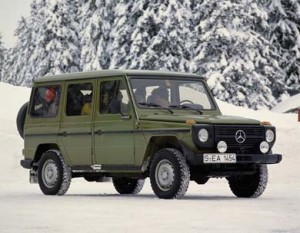 design of the new vehicle. A second team based in Graz focused mainly on the construction of the bodyshell, the development of the new transfer case and off-road testing. The frame-type chassis with two rigid axles provided an ideal basis for outstanding off-road characteristics.
design of the new vehicle. A second team based in Graz focused mainly on the construction of the bodyshell, the development of the new transfer case and off-road testing. The frame-type chassis with two rigid axles provided an ideal basis for outstanding off-road characteristics.
The exterior design of the car was another area where Mercedes-Benz refused to be diverted from the principal demands placed on a cross-country vehicle. The result was a clear, striking form. The defining features of the G-Class include its straight lines, the short overhangs and its square-cut wings, which allow a good view of the surface conditions and extremely precise driving.
 The designers initially chose to make the interior simple but functional and tailored, featuring painted metal surfaces and only a token number of trim elements. The driver looked through the two-spoke steering wheel at an unpretentious instrument panel with speedometer and indicator lights. A pushbutton switch was centrally positioned within easy reach, as were the controls for the heating and ventilation. However, the designers always had a more refined interior in
The designers initially chose to make the interior simple but functional and tailored, featuring painted metal surfaces and only a token number of trim elements. The driver looked through the two-spoke steering wheel at an unpretentious instrument panel with speedometer and indicator lights. A pushbutton switch was centrally positioned within easy reach, as were the controls for the heating and ventilation. However, the designers always had a more refined interior in  mind for the G-Model, including foamed elements to cover over some of the metal surfaces. It may have been tailored to meet practical, functional objectives, but the G-Class still boasts strong design aesthetics.
mind for the G-Model, including foamed elements to cover over some of the metal surfaces. It may have been tailored to meet practical, functional objectives, but the G-Class still boasts strong design aesthetics.
For practical testing on and off-road, the engineers selected several test tracks. One of the testing areas was located in the vast coalfields between Cologne and Aachen and another on inhospitable Alpine terrain at Steyr-Daimler-Puch’s own Schöckl test site. Further tests were undertaken in the remote desert regions  of North Africa, the loose gravel tracks of the Atlas mountains, the notorious “Chottel Djerid” salt lake in the Sahara – where corrosion tests were conducted – and the extreme winter cold beyond the Arctic circle.
of North Africa, the loose gravel tracks of the Atlas mountains, the notorious “Chottel Djerid” salt lake in the Sahara – where corrosion tests were conducted – and the extreme winter cold beyond the Arctic circle.
Under the terms of their basic cooperation agreement concluded in 1973, the two partner companies had established that the G-Class would be built using new production facilities on the premises of Steyr-Daimler-Puch AG in Graz. The decision to begin series production of the G-Model in 1975 was also the signal to commence planning of the 40,000 square-metre production 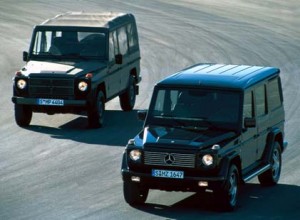 facility in Austria. To this day, the full range of the vehicle’s components is still hand-built by specialists at the plant.
facility in Austria. To this day, the full range of the vehicle’s components is still hand-built by specialists at the plant.
By February 10, 1979 the preparations were complete and production of the G‑Class could begin. The same month, the ‘G’ celebrated its world premiere at a press launch in the south of France, making an extremely positive all-round impression. When production initially got underway, customers had a choice of four engine variants (four-cylinder diesel with 53kW/72hp, five-cylinder diesel with 65kW/88hp, four-cylinder petrol engine with 75kW/100hp or 66kW/90hp and six-cylinder petrol engine with 110kW/150hp) –  available under the bonnet of a short-wheelbase Convertible or a Station Wagon or panel van with a short or long wheelbase. The range also included an open-top three or five-door military version with a long wheelbase and a canvas roof.
available under the bonnet of a short-wheelbase Convertible or a Station Wagon or panel van with a short or long wheelbase. The range also included an open-top three or five-door military version with a long wheelbase and a canvas roof.
The G-Class was launched under two different designations. In Austria, Switzerland and the COMECON countries it was sold under the “Puch” badge, while in all other countries it came with the Mercedes three-pointed star on the radiator grille. It is only since 2000 that the G-Class has been marketed under the Mercedes-Benz brand worldwide.
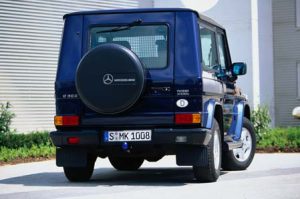 Although all models of the Mercedes-Benz off-roader produced in 1979 were fitted with a four-speed manual transmission, a four-speed automatic variant was made available as an alternative for the 280 GE and 300 D models a short while later. The G-Model was already making a name for itself, with the driver able to engage or disengage the four-wheel drive, off-road ratio and locks while on the move.
Although all models of the Mercedes-Benz off-roader produced in 1979 were fitted with a four-speed manual transmission, a four-speed automatic variant was made available as an alternative for the 280 GE and 300 D models a short while later. The G-Model was already making a name for itself, with the driver able to engage or disengage the four-wheel drive, off-road ratio and locks while on the move.
 Then as now, the robust basis for the G-Class was provided by a high-strength frame consisting of closed longitudinal sections and cross-members to ensure exceptional bending and torsional stiffness. The frame supports robust, rigid axles with large coil springs and long spring travel. Both these features are useful elements on rough terrain, maintaining a constant, pre-programmed ground clearance – one of the key factors underpinning the G-Class’s
Then as now, the robust basis for the G-Class was provided by a high-strength frame consisting of closed longitudinal sections and cross-members to ensure exceptional bending and torsional stiffness. The frame supports robust, rigid axles with large coil springs and long spring travel. Both these features are useful elements on rough terrain, maintaining a constant, pre-programmed ground clearance – one of the key factors underpinning the G-Class’s 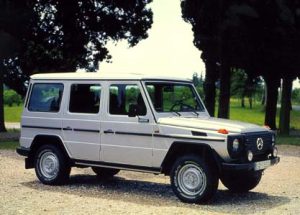 outstanding off-road qualities. These include an ability to scale gradients of up to 80 percent and preserve directional stability at a 54-percent tilt, allowing the vehicle to tackle even the toughest contours with ease. Ground clearance of 21 centimetres, an angle of approach of 36 degrees and an angle of departure of 27 degrees give the Mercedes cross-country star an extra edge off-road.
outstanding off-road qualities. These include an ability to scale gradients of up to 80 percent and preserve directional stability at a 54-percent tilt, allowing the vehicle to tackle even the toughest contours with ease. Ground clearance of 21 centimetres, an angle of approach of 36 degrees and an angle of departure of 27 degrees give the Mercedes cross-country star an extra edge off-road.
The automatic transmission announced at the vehicle’s premiere was introduced in 1981, along with an air conditioning system.  In 1982, the 2.3-litre engine was replaced by a newly designed power unit with fuel injection, which boosted output to 92 kW/125 hp.
In 1982, the 2.3-litre engine was replaced by a newly designed power unit with fuel injection, which boosted output to 92 kW/125 hp.
Continuing a proud tradition at Mercedes-Benz, the G-Model also proved to be a safe and secure form of transport for the Pope. The first so-called “Papamobile”, the modified 230 G was delivered in 1980. Its literally outstanding characteristic was a transparent dome of eight-millimetre thick plexiglas. This protected the Holy Father  from adverse weather conditions, but also made sure that he remained visible to his flock. In 1980 Pope John Paul II travelled through Germany for the first time in this G-Model. After the assassination attempt on the Pope in 1981 the protective dome was made bullet-proof. Since 2007 Pope Benedict XVI uses the new “Popemobile” which was created over a development time of almost two years in close collaboration with the Vatican, and is based on a G 500.
from adverse weather conditions, but also made sure that he remained visible to his flock. In 1980 Pope John Paul II travelled through Germany for the first time in this G-Model. After the assassination attempt on the Pope in 1981 the protective dome was made bullet-proof. Since 2007 Pope Benedict XVI uses the new “Popemobile” which was created over a development time of almost two years in close collaboration with the Vatican, and is based on a G 500.
At the International Motor Show in Frankfurt, Germany in September 1989, Mercedes-Benz presented a further G-Model upgrade to mark the model serie‘s 10th birthday. 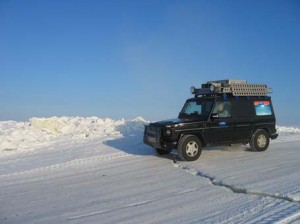 With a comprehensively revised interior, comfortable rear seat bench, interior body trim panels, a centre console, a new dashboard and trim elements in fine wood, the special-edition 230 GE Classic positively glowed with the aura of its new-found luxury. This exclusive anniversary model was produced in a limited edition of only 300 units, and remains one of the most widely coveted cross-country vehicles today.
With a comprehensively revised interior, comfortable rear seat bench, interior body trim panels, a centre console, a new dashboard and trim elements in fine wood, the special-edition 230 GE Classic positively glowed with the aura of its new-found luxury. This exclusive anniversary model was produced in a limited edition of only 300 units, and remains one of the most widely coveted cross-country vehicles today.
The comfort-oriented version of the Mercedes-Benz off-roader, which was launched in 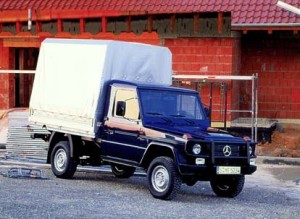 spring 1990, was given the series designation G 463 to distinguish it from the previous variant known as the G 460, which remained in the range mainly for utility-oriented users. The 463-series off-roader featured a permanent four-wheel drive system, while the front and rear differential locks and a 100-percent locking inter-axle differential were now standard equipment. The anti-lock braking system was available as an option, and the most powerful (125 kW/170 hp) “G” to date, the new 300 GE, announced its arrival at the top of the range.
spring 1990, was given the series designation G 463 to distinguish it from the previous variant known as the G 460, which remained in the range mainly for utility-oriented users. The 463-series off-roader featured a permanent four-wheel drive system, while the front and rear differential locks and a 100-percent locking inter-axle differential were now standard equipment. The anti-lock braking system was available as an option, and the most powerful (125 kW/170 hp) “G” to date, the new 300 GE, announced its arrival at the top of the range.  The revised version of the original 460 series – designed predominantly for municipal and commercial use – came onto the market in March 1992 to complement the more luxurious variant, intended for surveyors, foresters, landscape gardeners and craftsmen. This variant was initially available as the 230 GE and 290 GD, and later as the G 290 Turbodiesel.
The revised version of the original 460 series – designed predominantly for municipal and commercial use – came onto the market in March 1992 to complement the more luxurious variant, intended for surveyors, foresters, landscape gardeners and craftsmen. This variant was initially available as the 230 GE and 290 GD, and later as the G 290 Turbodiesel.
In spring 1993, the long history of the G-Class witnessed a new high point with the launch of the eight-cylinder 500 GE (177 kW/241 hp) in a small special-edition series of 500 units.
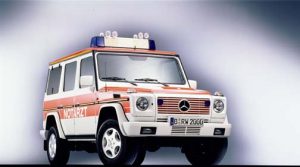 Mercedes-Benz launched the improved Convertible variant of the G-Class with an electropneumatically operated soft-top at the International Off-Road Show in Munich in 1997.
Mercedes-Benz launched the improved Convertible variant of the G-Class with an electropneumatically operated soft-top at the International Off-Road Show in Munich in 1997.
Since September 2001 the G-Class has also featured trailblazing handling stability, traction and braking control systems. The all-wheel drive system of the G-Class was perfected by the introduction of the electronically controlled traction system (4ETS) as standard. The Electronic Stability Program ESP and Brake Assist (BAS) were also included in the standard equipment of the G-Class from autumn 2001.
 A very special model enhanced by AMG was launched to mark the 25th anniversary of the G-Class – the G 55 AMG Kompressor. An eight-cylinder powerpack developing an output of 350 kW/476 hp and 700 newton metres of torque gave the robust off-roader an unprecedented performance. Two years later the engineers at AMG uprated the “Power G” even further, raising output to 368 kW/500 hp. The G 55 AMG accelerated from zero to 100 km/h in 5.5 seconds, while the top speed remained at an electronically limited 210 km/h. The latest development stage of this flagship model from 2007 continues to shine in the G-Class model range with an output of 373 kW/507 hp.
A very special model enhanced by AMG was launched to mark the 25th anniversary of the G-Class – the G 55 AMG Kompressor. An eight-cylinder powerpack developing an output of 350 kW/476 hp and 700 newton metres of torque gave the robust off-roader an unprecedented performance. Two years later the engineers at AMG uprated the “Power G” even further, raising output to 368 kW/500 hp. The G 55 AMG accelerated from zero to 100 km/h in 5.5 seconds, while the top speed remained at an electronically limited 210 km/h. The latest development stage of this flagship model from 2007 continues to shine in the G-Class model range with an output of 373 kW/507 hp.
 Following the final decision in 2006 to retain the model series in the Mercedes-Benz range into the future, the special “Grand Edition” model was introduced. This special edition available only with a long wheelbase and V8-engine was offered as the G 500 developing 218 kW (296 hp) or the diesel model G 400 CDI with 184 kW (250 hp). Specially for this special edition – and in line with the natural charm of the G-Class – an open-pored, natural leather with no embossing was used.
Following the final decision in 2006 to retain the model series in the Mercedes-Benz range into the future, the special “Grand Edition” model was introduced. This special edition available only with a long wheelbase and V8-engine was offered as the G 500 developing 218 kW (296 hp) or the diesel model G 400 CDI with 184 kW (250 hp). Specially for this special edition – and in line with the natural charm of the G-Class – an open-pored, natural leather with no embossing was used.
 In the same year the G-Class was given a new, ultra-modern diesel engine. The G 320 CDI, which still features strongly in the model range and is regarded as one of the best “Gs” of all times by many enthusiasts, has an output of 165 kW/224 hp and features a diesel particulate filter as standard. The latest, third-generation common-rail direct injection with piezo-electric injectors, four-valve technology and a turbocharger with electrically adjustable vanes were just some of the advantages of this powerful engine, whose power was transferred by the standard 7G-TRONIC seven-speed automatic transmission.
In the same year the G-Class was given a new, ultra-modern diesel engine. The G 320 CDI, which still features strongly in the model range and is regarded as one of the best “Gs” of all times by many enthusiasts, has an output of 165 kW/224 hp and features a diesel particulate filter as standard. The latest, third-generation common-rail direct injection with piezo-electric injectors, four-valve technology and a turbocharger with electrically adjustable vanes were just some of the advantages of this powerful engine, whose power was transferred by the standard 7G-TRONIC seven-speed automatic transmission.
 With the 2007 model facelift, Mercedes-Benz added new highlights to the G-Class – especially in the interior.
With the 2007 model facelift, Mercedes-Benz added new highlights to the G-Class – especially in the interior.
Indeed, the G-Class’s military career in the early days of the vehicle’s introduction helped to establish it in the wider market. In the very recent past, various G-models have also proved extremely popular in military circles. Not only do the German armed services continue to order the “Wolf”, but the Australian government also ordered 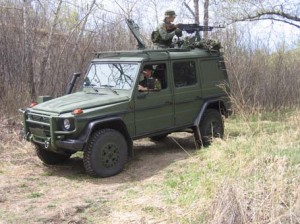 1200 units of the GT-Class last year. 600 of these 1200 units will have a 4×4 configuration (all-wheel drive with two axles) and 600 will have a 6×6 configuration (all-wheel drive with three axles). The 6×6 is a new, three-axle G-Class design which takes the particular payload requirements of the Australian army into consideration.
1200 units of the GT-Class last year. 600 of these 1200 units will have a 4×4 configuration (all-wheel drive with two axles) and 600 will have a 6×6 configuration (all-wheel drive with three axles). The 6×6 is a new, three-axle G-Class design which takes the particular payload requirements of the Australian army into consideration.
Category: HISTORY



















